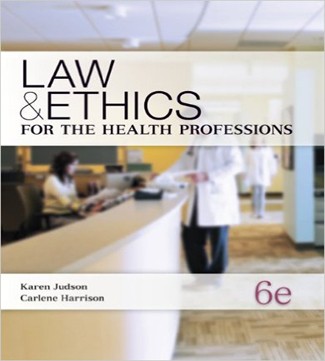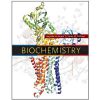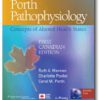Law and Ethics for the Health Professions 6th Edition Judson Harrison Test Bank
$35.00 Original price was: $35.00.$26.50Current price is: $26.50.
Law and Ethics for the Health Professions 6th Edition Judson Harrison Test Bank
Instant download Law and Ethics for the Health Professions 6th Edition Judson Harrison Test Bank pdf docx epub after payment.

Product Details:
- ISBN-10 : 0073374717
- ISBN-13 : 978-0073374710
- Author: Karen Judson (Author), Carlene Harrison (Author)
Law and Ethics for the Health Care Professions illustrates the numerous legal and ethical issues that health care professionals face every day. The topics are derived from real-life experiences and dilemmas from a variety of health care practitioners. Through the use of Learning Outcomes, Key Terms, Ethics Issues, Chapter Reviews, Case Studies, Internet Activities, Court Cases, and Video Vignettes, students hear from health care practitioners in various locations throughout the United States as they encounter legal and ethical problems and situations. Students will practice critical thinking skills to decide how to resolve the real-life situations or theoretical scenarios, determine why the court made a particular ruling and decide how the issues are relevant to the health care profession they will practice.
Table of Content:
1. A pediatrician completes all the state requirements for mandatory credentialing allowing him to practice
in a community health clinic. Which of the following has this physician achieved?
A. Certification
B. Licensure
C. Permit
D. Accreditation
2. An RN is attempting to obtain certification as a nurse anesthetist (CRNA). Which of the following
characterizes this process?
A. It is a mandatory credentialing process.
B. It is usually state sponsored.
C. It places the professional’s name on a register.
D. It signifies an applicant has attained a certain level of skill.
3. A pharmacist is joining a registry to further her career. Which of the following is true regarding this
process?
A.Under certain conditions, unregistered individuals may be prevented from working in a field in which
they are qualified.
B. The individual must pay a fee and meet certain criteria to apply for registration in his or her field.
C. The list is private and is not made available to health care providers or health care consumers.
D
.
When simply adding one’s name to a registry list, unregistered persons are prevented from working in a
field in which they are qualified.
4. A health care provider is explaining to staff members about the accreditation process. Which of the
following may be accredited?
A. A physician
B. A pharmacist
C. A Hospital
D. A pharmaceutical company
5. A university is undergoing the process of accreditation for its nursing program. Which of the following is
a characteristic of the accreditation process?
A. It is a credentialing procedure that places the name of the university on a registry.
B. It is an official approval of the curriculum for conforming to a specified standard.
C. It certifies applicants who meet specific requirements in the curriculum
D. It is a mandatory credentialing process for the university established by law.
6. The administer of a long-term care facility is applying for accreditation of the facility. Which of the
following organizations is involved in this process?
A. The Joint Commission
B. The Food and Drug Administration
C. The National Committee for Quality Assurance
D. The Commission on Accreditation of Allied Health Education Programs
7. The administrator of a hospital instructs the staff on measures to take to maintain Joint Commission
accreditation. Which of the following is a requirement?
A. The hospital must undergo an on-site survey by a TJC survey team every three years.
B. Laboratories in the hospital must be surveyed every year.
C. Consumer satisfaction surveys must be conducted every year.
D. On-site reviews of key clinical and administrative processes must be done yearly.
8. A recognized accrediting agency for managed care plans is the National Committee for Quality
Assurance (NCQA), an independent, nonprofit organization that evaluates and reports on the quality of
the nation’s managed care organizations. Which of the following is a method this organization uses to
evaluate managed care programs?
A. Off-site reviews of the managed-care-program
B. Use of employee satisfaction surveys
C. On-site surveys of members of the program
D. Use of the HEDIS to measure performance
9. A managed health care plan is accredited by the National Committee for Quality Assurance (NCQA).
Which of the following is accurate regarding participation in this certification program?
A. Participation is mandatory.
B. 95% of all Americans are enrolled in accredited HMOs.
C. Approximately half the nation’s HMOs are accredited.
D. Health plans in every state except Florida and California are accredited.
10. An LPN who is living in Pennsylvania is seeking a new job located in New Jersey. What will usually
occur with this nurse’s license?
A. It will be revoked.
B. It will transfer to the new state.
C. It will become inactive.
D. It will be reissued following new testing.
11. A physician who is moving to another state to practice medicine is asking the new health care facility to
accept his old license to practice. What is the term for this practice?
A. Licensure
B. Reciprocity
C. Recertification
D. Credential transfer
12. An RN moving to another state to practice is not granted reciprocity. What recourse does this nurse have?
A. Take the required examination to obtain a valid license in the new state.
B. Practice in the new state anyway under the old state’s license.
C. Take an in-service class in the new state to be granted a new license.
D. Submit the hours accrued in the old state to obtain a license in the new state.
13. A student is in a program to obtain a Doctor of Medicine (MD) degree. How many years of education
post high school must this student complete?
A. 4
B. 6
C. 8
D. 10
14. A newly graduated physician is taking the United States Medical Licensing Examination (USMLE) to
complete his education. Which of the following is an aspect of this process?
A. Student physicians take Part 1 of the exam after the second year of medical school.
B. Student physicians take Part 2 of the exam during the third year of medical school.
C. Student physicians take exam Part 1 and 2 during the fourth year of medical school.
D. Student physicians take Part 3 of the exam during post graduate medical training.
15. A physician is completing a residency to complete her education. Which of the following accurately
describes this process?
A. It is a period of practical postgraduate training in a hospital.
B. It is a period in which the physician is a resident physician in a nursing home.
C. It includes three years of training as an intern in a hospital.
D. It is a four-year process that certifies the physician as a NBME Diplomate.
16. A physician who is a National Board of Medical Examiners (NBME) diplomate is choosing a specialty.
How many more years of training does completing a specialty involve?
A. 1 to 2
B. 2 to 4
C. 2 to 6
D. 4 to 8
17. A physician is applying to the American Board of Medical Specialties (ABMS) to take an exam in the
specialty of obstetrics. Which of the following would become the title of this physician after passing the
exam?
A. Doctor of osteopathy
B. Board-certified obstetrician
C. Advance degree obstetrician
D. State accredited obstetrician
18. A physician graduates with a Doctor of Osteopathy (DO) degree. What is the minimum amount of
training this physician has completed to obtain this degree?
A. 8 years
B. 10 years
C. 12 years
D. 14 years
19. Both Doctors of Medicine (MDs) and Doctors of Osteopathy (DOs) follow rigid requirements to obtain a
degree in their field. Which of the following is the basic difference between these two degrees?
A. MDs require more years of training to complete the program
B. DOs are not allowed to prescribe drugs.
C. DOs are not allowed to practice surgery
D. MDs are trained in allopathic medicine
20. Osteopathic and medical doctors can practice as generalists or primary care physicians or they can
specialize in a particular type of medicine. Which of the following is a specialty in medicine?
A. Orthopedics
B. Family medicine
C. Internist
D. General pediatrics
21. Doctors of Medicine (MDs) practice allopathic medicine. What is the emphasize of this type of medicine?
A. Focusing on manipulating the musculoskeletal system to relieve symptoms.
B. Using drugs or surgery to alleviate symptoms.
C. Using holistic care in the practice of medicine.
D. Correcting joint and tissue problems.
22. Recent U.S. government statistics show that in the United States, medical students are three times
more likely to specialize than to remain generalists or primary care physicians. Which of the following
accurately describes one of the reasons doctors specialize?
A. Specialists can make up to three times more money than generalists.
B. Most medical training is provided in primary care settings.
C. There is increased exposure to generalists who are role models.
D. There is a lack of attractiveness of general practice in rural and underserved areas.
23. Most medical training is provided in tertiary care settings. Which of the following is an example of a
tertiary care setting?
A. Physician’s office
B. Community health care clinic
C. Trauma center
D. Mobile clinic serving migrant workers
24. A physician educated in a foreign medical school is moving to the United States to practice medicine in
a community clinic. Which of the following is the requirement for this physician to practice in the U.S.?
A. Graduating from a two-year medical school for foreign doctors
B. Passing the Clinical Skills Assessment Exam (CSAE)
C. Serving a four year residency
D. Passing the CSAE and serving a 2-year residency
25. A physician has finished her education and obtained a license to practice as an internist. Under what
jurisdiction does the continuation of licensure fall?
A. Federal medical board
B. Drug Enforcement Administration
C. State medical board
D. Joint Accreditation Commission
26. A physician applies for a license to practice medicine in the state of California. Which of the following is
a criteria for the granting of this license?
A. The physician must have registered to take the medical boards.
B. The physician must have completed medical school and be an intern.
C. The physician must be of good moral character.
D. The physician must be at least 25-years old.
27. A physician is moving to another state to practice medicine and has been granted endorsement. What
does this process signify?
A. A license was awarded based on credentials judged to meet license requirements.
B. Prior agreement between the two states has been made to accept license transfer.
C. The physician’s credentials will be placed on a registry for the area.
D. A mentor will be appointed in the new state to help the physician adjust.
28. There are situations when physicians do not need a valid license to practice medicine in a specific state.
Which of the following is an example of one of these situations?
A. A physician is practicing medicine in an underserved area.
B. A physician is engaged solely in research, and not treating patients.
C. A physician is employed by a state facility.
D. A physician is caring for patients who are in a hospice program.
29. A physician’s license can be revoked for conviction of a felony, unprofessional conduct, or personal or
professional incapacity. Which of the following is considered unprofessional conduct?
A. Conviction of rape
B. Conviction of tax evasion
C. Falsifying records
D. Having dementia related to Alzheimer’s disease
30. In all 50 states, medical practice acts have been established by statute to govern the practice of medicine.
Which of the following is a primary mandate of these medical practice acts?
A. Explain the process of accreditation.
B. Investigate the background of physician applicants.
C. Designate where physicians with certain specialties may practice.
D. Define what is meant by “practice of medicine” in each state.
31. A physician researches the establishment of medical practice acts. Which of the following statements
accurately describes this legislation?
A. The acts were first passed in the early 1900s.
B. The acts were repealed in the 1900s and reenacted later due to rampant quackery.
C. The acts mandate the establishment of medical boards.
D. The funding for medical boards comes from state taxes.
People Also Search:
law & ethics for the health professions 6th edition
law & ethics for the health professions
law & ethics for the health professions 6th edition testbank download pdf
law & ethics for the health professions 6th edition download scribd
Related products
Test Bank
Test Bank for Operating Systems: Internals and Design Principles, 7th Edition: William Stallings
Test Bank
Test Bank for Decision Support and Business Intelligence Systems, 9th Edition: Efraim Turban











